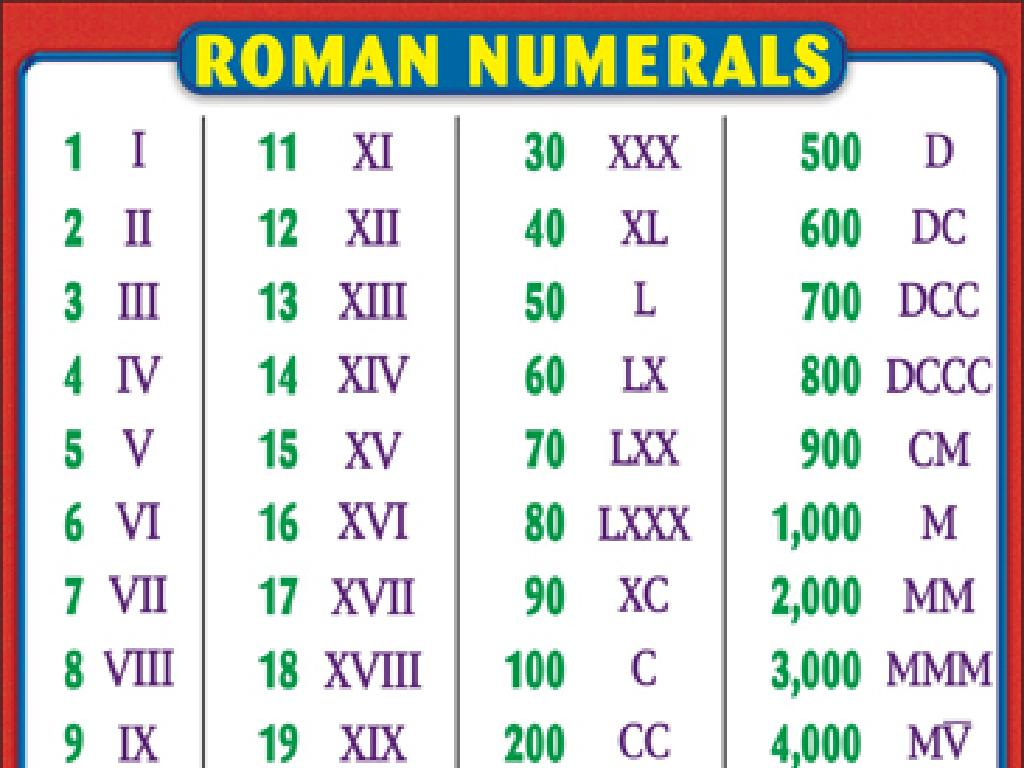Understanding Absolute Value
Subject: Math
Grade: Seventh grade
Topic: Integers
Please LOG IN to download the presentation. Access is available to registered users only.
View More Content
Integers and Absolute Value
– Understanding Integers
– Integers include whole numbers and their negatives
– Defining Absolute Value
– Absolute value is the distance from zero on a number line
– Importance of Absolute Value
– It measures magnitude regardless of direction
– Examples and Applications
– Use in real-life: depths, elevations, and temperatures
|
This slide introduces the concept of integers and absolute value to seventh-grade students. Begin by explaining that integers are the set of whole numbers including zero, positive numbers, and their negative counterparts. Then, define absolute value as the distance a number is from zero on the number line, which is always a positive value or zero. Emphasize that absolute value is used to express the magnitude of a number without considering its direction (positive or negative). Provide examples such as the depth below sea level, elevation above sea level, and temperature changes to illustrate the concept. Encourage students to think of other situations where only the size or quantity matters, not whether it’s positive or negative.
Understanding Integers and Absolute Value
– Integers: Positive and Negative
– Integers include whole numbers, their negatives, and zero.
– Absolute Value Concept
– Absolute value measures distance from zero, ignoring direction.
– Real-world Integer Applications
– Temperatures, bank balances, and elevations are integer examples.
– Comparing Integers
– Use a number line to visualize and compare integer values.
|
This slide introduces the concept of integers and their absolute values, which are crucial in understanding mathematical operations and real-life applications. Integers encompass the set of whole numbers, their opposites, and zero. Emphasize that absolute value represents the distance of a number from zero on a number line, regardless of direction, which is why it’s always positive or zero. Provide relatable examples such as temperature changes, financial transactions, and altitude levels to illustrate the use of integers in everyday life. Encourage students to think of other examples and use a number line to compare different integers, reinforcing the concept of absolute value.
Exploring Absolute Value
– Absolute value defined
– The absolute value of a number is its distance from 0, regardless of direction.
– Distance from zero on a number line
– For example, both -3 and 3 are 3 units away from 0.
– Absolute value is non-negative
– No matter the number, absolute value is 0 or positive.
– Real-world applications
– E.g., |debt| or |altitude| shows magnitude without negative sign.
|
This slide introduces the concept of absolute value to seventh-grade students. Begin by defining absolute value as the distance a number is from zero on the number line, emphasizing that it does not consider direction. Illustrate this with examples of positive and negative numbers, showing that both have the same absolute value. Clarify that absolute value is always a non-negative number, as it represents a magnitude without direction. To help students relate, discuss real-world scenarios where absolute value is used, such as measuring the depth of a submarine (altitude) or the amount of money owed (debt), where only the size of the value matters, not whether it is positive or negative.
Calculating Absolute Value
– Absolute value definition
– The distance of a number from 0 on a number line, always non-negative
– Examples: |7| and |-7|
– |7| = 7 and |-7| = 7 show distance without regard to direction
– Steps to find absolute value
– To find |a|, if a is positive or 0, |a| = a; if a is negative, |a| = -a
– Practice with problems
|
Introduce the concept of absolute value as the distance a number is from zero on the number line, emphasizing that it is always a positive value or zero. Use |7| and |-7| as clear examples to show that absolute value reflects magnitude without direction. Walk through the steps to calculate absolute value, highlighting the rule for positive, negative, and zero values. Provide practice problems for students to apply their understanding, ensuring a variety of positive and negative numbers, and possibly zero, to reinforce the concept.
Real-Life Applications of Absolute Value
– Understanding temperature changes
– Absolute value shows how much temperature deviates from 0.
– Measuring elevations below sea level
– It represents depth regardless of being above or below sea level.
– Analyzing financial gains and losses
– Absolute value helps understand overall financial changes.
|
This slide aims to illustrate the concept of absolute value through practical examples that students can relate to. Absolute value is used to express the magnitude of a number without considering its sign, which is particularly useful in real-life scenarios. For instance, when discussing temperature, the absolute value can represent how far the temperature is from a baseline, such as 0 degrees. In geography, it can measure the depth of a location relative to sea level, regardless of whether it’s above or below. In finance, absolute value is crucial for understanding the total impact of gains and losses in a portfolio. Encourage students to think of other areas where absolute value might be applicable and to consider how it simplifies the understanding of magnitude in various contexts.
Class Activity: Exploring Absolute Values
– Pair up and solve problems
– Share solutions with the class
– Discuss absolute value applications
– How does absolute value function in daily life, like distances or temperatures?
– Reflect on the activity
– Think about what you’ve learned and how you can use it.
|
This activity is designed to promote collaborative learning and to deepen students’ understanding of absolute value. Have students pair up and work through a set of problems that require them to find the absolute value of integers. After solving the problems, each pair will share their solutions with the class, fostering a collaborative environment. Encourage a discussion on how absolute value is used in real-world scenarios, such as finding the distance between two points or understanding temperature changes. Conclude the activity by asking students to reflect on their learning experience and how they can apply this knowledge in practical situations. Possible activities: measuring distances on a map, comparing temperatures from different days, or calculating financial gains and losses.
Wrapping Up: Absolute Value
– Recap: What is absolute value?
The distance of a number from zero on a number line, regardless of direction.
– Why master absolute value?
Understanding absolute value is crucial for solving real-world problems and higher math.
– Homework: Practice worksheet
Complete the worksheet to solve absolute value problems.
– Next class: Applying absolute value
|
As we conclude today’s lesson, remind students that the absolute value of a number is its distance from zero on the number line, without considering direction. Emphasize the importance of mastering this concept as it lays the foundation for more complex mathematical operations and its application in real-life situations, such as finding the difference in elevation. For homework, students are assigned a worksheet that includes a variety of absolute value problems to reinforce their understanding. In the next class, we will delve into applying absolute value in different contexts, ensuring students are comfortable with the concept and its applications.






